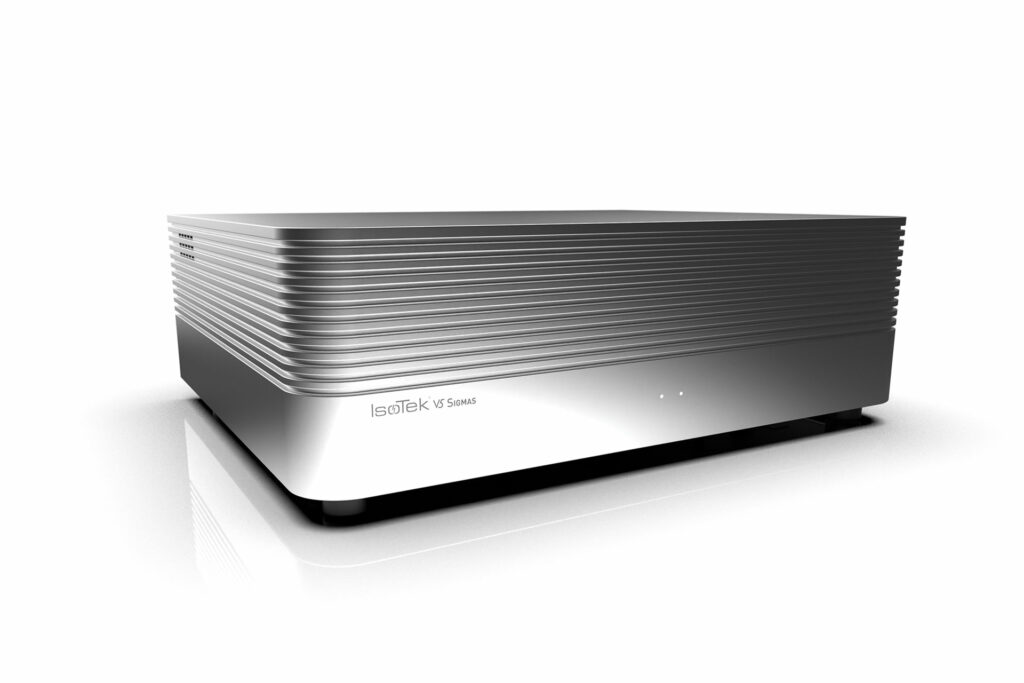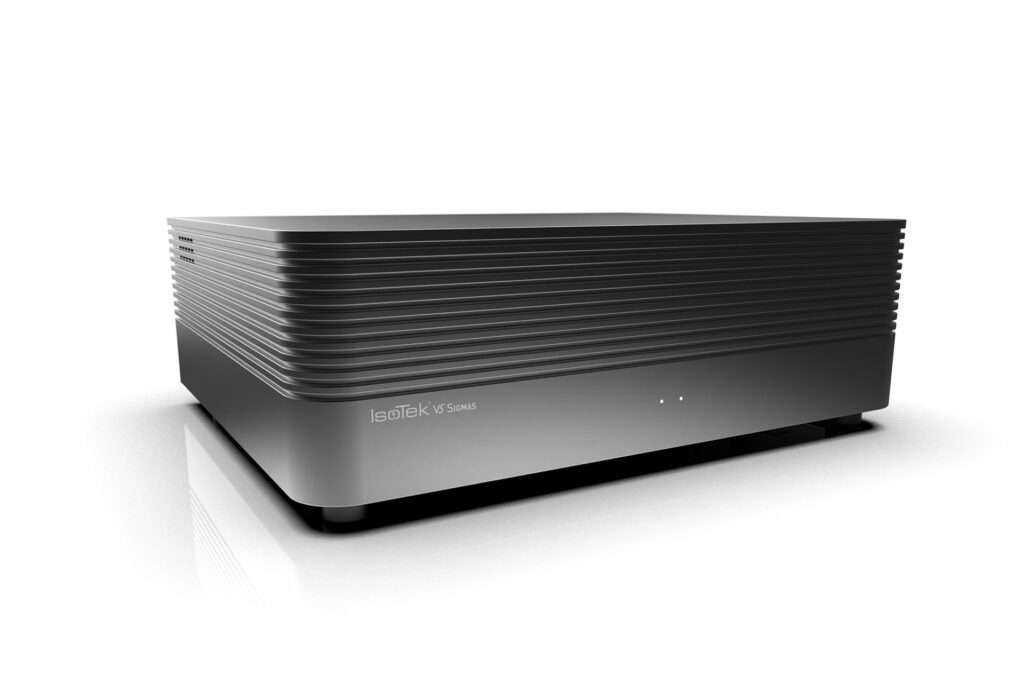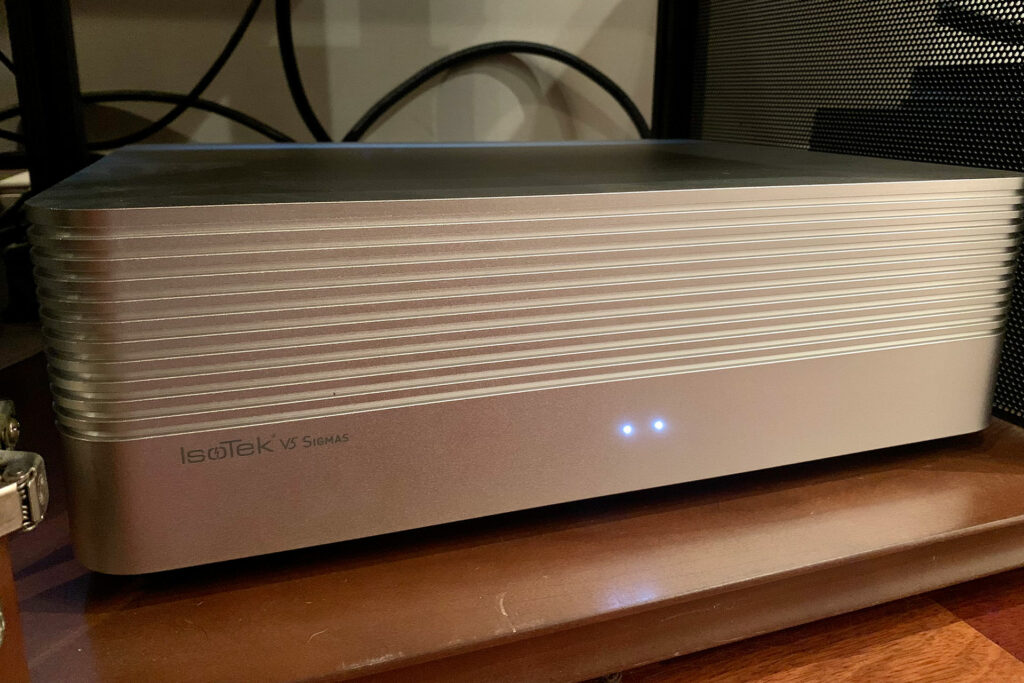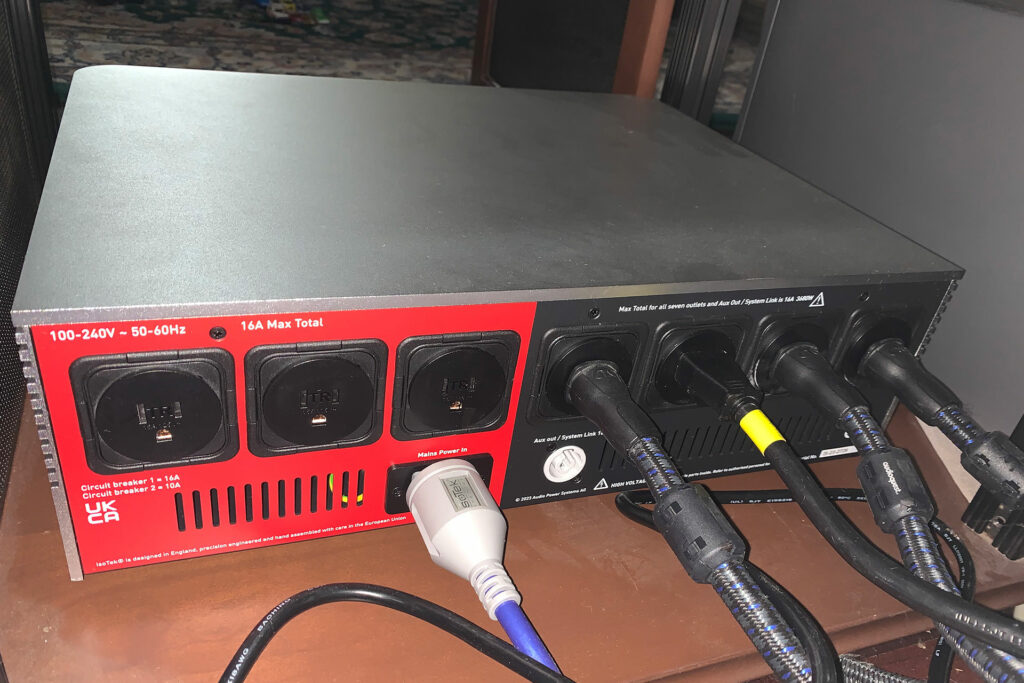My relationship with power conditioning products has always been a complex one. Over the years I’ve tried several from very respected brands, but not IsoTek. Most provided some sort of sonic improvement to my system, while others seemed to do nothing that I could easily hear. What I found was that, even with the best of the conditioners, there was always a penalty that had to be paid. My general experience was that I could get an improvement in clarity, but at the expense of dynamics, which always left me unsatisfied. Inevitably, I ended up removing the conditioner from the system and going back to plugging directly into the outlet. When I was asked to review the latest V5 power cleaner product from IsoTek, I was curious if the story would end the same as it always had in the past.
IsoTek, which stands for isolation technology, is a U.K.-based company that has been around for around two decades doing only one thing: cleaning up the power that comes from your outlet. Their products are so highly regarded that they are used in the recording studio of the Universal Music Groups (UMG) audiophile recording division, as well as by high-end electronics manufacturers, such as Arcam, Innous, Nordost and Teac/Esoteric. An impressive list, for sure.
The V5 Sigmas is one of IsoTek’s latest V5 generation of products offering improvements over their highly-regarded Evo3 products. The V5 Sigmas is designed to provide power for an entire system with seven outputs, three of which are high-current for things like power amplifiers or powered subwoofers. Included with the V5 Sigmas is a very high-quality EVO3 Premier 20 Amp power cord.

What Makes the IsoTek V5 Sigmas Power Conditioner Special?
- The IsoTek products offer beautiful styling and construction. The V5 Sigmas has excellent build quality. The IsoTek V5 Sigmas has a rugged industrial grade feel to it, but is still attractive. The metal case is very nicely finished, with rounded corners and an interesting ribbed design befitting a high-end audio component. The front has two white status LEDs and the logo, simple. If the LEDs are on, then all is well. If one or both are out, then you had an issue which tripped one or both of the circuit breakers. The rear of the unit is all business, with sturdy outlets colored either red for high-current devices or black for source devices. Underneath, you will find the high-quality circuit breakers, one for each bank of outlets. Rubber feet keep the units from sliding, while inserting power cords into the outlets, which are very snug.
- The main benefit of the IsoTek products is noise reduction. IsoTek power cleaners remove differential and common mode noise that degrades your incoming power and affects system performance. Differential mode noise is created by power supplies. Almost everything that gets plugged into your wall has them: think computers, appliances, televisions, and so on. Common mode noise comes from all of the radio frequencies, such as cellular, Wi-Fi, and broadcasting that are around us all the time. The wiring in your home acts as an antenna, and this too degrades the purity of the incoming sinusoidal power. The good news is that the IsoTek V5 Sigmas is designed to combat both, and offers 80dB of RFI noise reduction.
- The IsoTek audiophile power products offer independent outlets. IsoTek isolates each outlet from the others, so that no two outlets are ever directly connected together. Lesser designs will often daisy-chain the multiple outlets together. What IsoTek does eliminates noise from one device finding its way into another in the form of differential mode noise.
- Adaptive gating is very cool. The circuitry that IsoTek developed is dynamic in its execution. It is constantly adjusting the amount of filtration that is being used on an outlet, based on how much current is being demanded. This technique allows the V5 Sigmas to filter the noise out of the incoming power, without limiting the dynamics of the music.
- The IsoTek audiophile power conditioners use KERP technology. KERP stands for Kirchoff’s equal resistance path. Kirchoff’s Law states that the current entering a junction is equal to the current leaving a junction. Simple enough for a circuit with a single path. For this example, you can equate a path with an outlet. If the V5 Sigmas only had a single outlet, KERP wouldn’t matter. However, when you have multiple outlets, the current to each is dictated by the resistance of the path to each outlet. A path with lower resistance will get more current as Ohm’s law dictates. Why does this matter? If you want each outlet to have the same current, each circuit path must have identical resistances. KERP ensures that each internal circuit is resistance-matched, so each has the same power delivery capability. This is important.
- Star earth design is in play with the IsoTek AC power products. Star earthing is a design technique where the ground point for all of the outlets tie back to a common point. This keeps all of the outlet grounds at exactly the same reference. Other designs may use a grounding bus bar, which all the outlets tie to at different points along the bar. This results in ground references, which are fractionally different to one another, and degrades performance. Grounding is extremely important, and a star system is ideal. IsoTek also allows you to add additional units with their System Link technology, while maintaining the ground reference. Simply use one of the System Link cables between IsoTek cleaners, and all devices will be at the same ground reference.
- Expect to see high-quality build materials. One example of the quality of components that IsoTek uses is the ultra-pure Ohno continuous cast copper solid core conductors, which are then silver-plated and used within the V5 Sigmas. Ohno refers to a molding technique developed by Professor Atsumi Ohno of Chiba Institute of Technology in Japan. It uses specialized heated molds, which results in significant reductions in annealing issues during the drawing process. Essentially, this process takes the copper crystal structure and stretches it, reducing the number of crystal junctions that a signal must cross as it passes down the wire. Standard high-purity copper has approximately 1,500 crystal boundary junctions per foot, while Ohno copper can have a copper grain that stretches over 700 feet, with zero crystal junctions to cross. It also has far fewer impurities than oxygen-free copper, but is obviously more expensive to produce. Fewer junctions for the signal to cross is better.
- The IsoTek gear delivers lean power for your entire audiophile system. The V5 Sigmas provides seven outlets, enough to power an entire system. Four of the outlets are medium current, meaning they are designed for components that have a more constant current draw, such as preamps, streamers or disc players. These outlets use a small amount of direct current resistance (DCR) to provide more power cleaning capability, and provide a maximum of 10A each. The three remaining high-current outlets utilize a scaled-down version of the V5 Titan’s direct-coupled circuit, which prioritizes lower DCR compared to the medium outlets. Medium current x4 outlets output about 1150 Watts at 115V and 2,300 Watts at 230V total. There are three high current outlets with 1,840 Watts @ 115V and 3,680 Watts at 230V total.
- Power surge protection is yet another perk. The V5 Sigmas will protect your equipment from instantaneous surges up to 121,500 amps. I’m one of those people who unplugs my gear any time a storm approaches, but sometimes I’m away. Knowing the V5 Sigmas is protecting my system is great peace of mind.
Why Should You Care About the V5 Sigmas Power Cleaner?
If you are considering the V5 Sigmas power cleaner, you’re looking to take your system to the next level and protect it at the same time. You want improved imaging and reduced noise, but are not willing to sacrifice dynamics. You also want something that can protect your equipment from power surges.

Some Things You Might Not Like About the IsoTek V5 Sigma Power Conditioners
- The circuit breakers are difficult to reset. We hope you never have a surge condition in your home. However, if you do, the circuit breakers are located on the bottom of the chassis. There are two breakers, one for the medium power outlets, and another for the high-power outlets. The V5 Sigmas is not overly heavy at 33 pounds, but if you have these in a rack, it may require you pull the chassis out to gain access and reset the breakers.
- The status lights are bright in a dim audiophile listening room. The V5 Sigmas has two status lights on the front of the unit, one for each circuit breaker. If a breaker trips, then the status light extinguishes. The downside is that these lights are bright and can be distracting at night when listening. I would like to see an option to disable these. In my case, I use a small piece of tape to cover them.
- The offered warranty is a bit short at three years. The V5 Sigmas only comes with a three-year warranty, while most of its competitors offer five years.

Listening to the IsoTek V5 Sigmas …
My current system consists of a Lumin U1 mini-streamer, Weiss Helios DAC, Pass Labs XP-22preamplifier and a CH Precision M1.1 Stereo Amplifier. I plugged the two power cords from the M1.1 into the high-current outlets and the rest of my devices into the medium-power outlets of the V5 Sigmas. Connections were firm and snug. Then I used the Evo3 Premier power cord to connect to my wall outlet. Let’s see how it sounds …
Robert Plant’s solo album Now and Zen holds a special place in my heart, and always takes me back good times in my life. I’ve heard it countless times and always enjoy the times I dust it off and give it another listen. “Ship of Fools” opens with a lone guitar and some interesting sonar-like percussion pings, which add tension. Listening to this song with the V5 Sigmas in the system was eye-opening. The guitar notes were clearer, better defined, and each note hung in the air a little longer. I heard more isolation between the guitar and each ping. The soundstage had more clearly defined levels of depth with the guitar backstage, and the pings front right. My system does a great job of soundstaging, but the V5 Sigmas made it better, denser and more clearly defined. Almost two minutes into the song, the drums come in strong, and I noticed immediately that the kick was punchy, deep and ultra-quick. I was pleasantly surprised, as typically this is precisely what suffers with other power products I have tried. I detected no loss of dynamics, but instead heard more detail with each snap of the bass drum beater.
Deciding to dig a little deeper into my catalogue brought me to another fantastic album from my past. Undertow is Tool’s 1993 debut album and offered a stark contrast to the grunge that was ruling the airwaves at that time. Tool is a hard-charging, loud rock band that is smart, thought-provoking, well-recorded and just badass. “Prison Sex” was the first Tool song I ever heard, while studying with a fellow electrical engineering student, and it was like nothing I had ever heard before. The entire album is an assault on the senses. “Prison Sex” opens with a guitar pick being slowly dragged up a string, creating a horror film mood. It’s fitting for a song that is about as dark a topic as can be. The sound of that pick on the strings echoes off both sides of the soundstage, and off the wall behind the guitarist. I haven’t heard it quite like this before. The echoes lasted a few cycles longer than I remember. There is more information presented to my ears that let me see deeper into the performance of Adam Jones. Shortly after, Danny Carey’s drums come thundering in, pushing the song forward with anger and aggression. As with Ship of Fools, the kick drum had all the visceral impact that I expected. With bassist Paul D’Amour working with Carey’s drums, the rhythm section is deep, thick and heavy, but also fast and accurate. Again, no loss of dynamics here. Maynard James Keenan’s vocals were clear and isolated from everything else going on around him. The V5 Sigmas made it all sound better.
Will the IsoTek V5 Sigmas Hold Its Value?
IsoTek is a very highly-regarded and well-established manufacturer that has been making high-performance products for a long time. Their products are well-engineered, with excellent construction and should last a lifetime. I checked a few places, and did find a few IsoTek products for sale, likely from owners looking to upgrade to the new V5 products. The asking prices were still very healthy, indicating that even on the used market, IsoTek products hold value.

What is the Competition for the IsoTek V5 Sigma Audiophile Power Conditioners?
Power conditioning products are absolutely everywhere. Everyone seems to build them, varying from entry-level to stratospheric in pricing. The IsoTek V5 Sigmas falls in the middle tier of the product range, where there are lots of competitive products to choose from.
Let’s start with the AudioQuest Niagara 5000, which retails for $5,900. The Niagara line of products from AudioQuest has received excellent reviews. Fellow Future Audiophile reviewer Paul Wilson has the big brother Niagara 7000 in his system. The Niagara 5000 looks and feels like an ultra-high-end product. AudioQuest did an excellent job with the styling. The Niagara 5000 offers five more outlets than the V5 Sigmas and offers transient power correction, but it does not include a power cord. Warranty is five years on the Niagara.
Another slightly more expensive option is the $7,600 Reference Power Isolator from Transparent Audio. The Power Isolator offers eight high-current outlets in four isolated banks of two, plus an Ethernet port to protect your system from surges on your networking infrastructure. This is increasingly important, as almost all systems use a networked device for streaming. The Power Isolator uses a parallel filter design, which does not restrict current. Transparent includes a high-quality Reference power cable with the Reference Power Isolator, which alone sells for $1,350. In typical Transparent fashion, it’s a gorgeous unit and receives lots of praise.

Final Thoughts on the IsoTek V5 Sigma Audiophile Power Conditioners …
As previously stated, my experience with power conditioning products was always mixed. Most gave me something positive, but they all came with a downside. My time with the IsoTek V5 Sigmas was different. The V5 Sigmas brought lots of positives to the table without the downsides I was expecting, such as reduced dynamics or softening of high frequencies. I experienced neither.
Removing noise is always a good thing, and it was obvious to my ears that the V5 Sigmas was doing a lot of it. When noise is reduced, imaging gets better, focus improves, soundstage expands. Music becomes more engaging when you hear deeper into the recording. My system sounded better with the V5 Sigmas in it.




Interesting review on a product I have not read a lot about, its made in the UK so should work well on UK 240 volt mains outlets. but I’m not sure if you think its better than Audioquest products or just different. Audioquest is made to work on USA Balance Mains output voltage.
I think most good audiophile power products work on 120v as well as 220v.
Hi Jon. I did not compare this to any other conditioners but I was very, very impressed with the Isotek. I bet if you find your local dealer you may be able to get a demo to hear for yourself. I was sad to see it leave my system!
Considering that these top level power conditioners weight like 100 pounds each (or more) that can be a real problem in terms of physical logistics.
Shipping costs for reviews is another one.
Perhaps that is too much “how the sausage is made” answer but it is the truth… 🙂
Jerry
Hi Jim. Great article. To realize the benefits you experienced with the Sigmas, is it necessary to be in that price range for a conditioner? I understand this may be too subjective, but I’d appreciate your thoughts. Thank you.
Hi David, first of all thank you. I’m glad you liked my review. I am not a believer in assuming performance based on price points. I’ve been very disappointed with some very expensive products, and thrilled with budget friendly equipment. What I can say however about the Sigmas is that it’s a VERY fairly priced product considering the performance I experienced. Always trust your ears first and foremost and be sure to listen to it for yourself. Only then will you know if it’s the right fit for your system.
Thanks, Jim. I’m looking forward to seeing more of your reviews.
Regarding the IsoTek V5 and your explanation of KERP: While it’s true that Kirchoff’s current law states that the current entering a node (or junction) equals the current leaving the node, conversely the current leaving a node is equal to the current entering a node, having equal resistance to each outlet is a detriment: A wall outlet will generally provide unlimited power (i.e. current) which is what make an ac outlet potentially dangerous. Aside from that, each piece of equipment plugged into an ordinary outlet strip will draw whatever current it requires. If the equipment connected to outlet A requires 5 amps and the equipment connected to outlet B requires 10 amps then that’s what will be drawn from the wall presuming there is no resistance preventing the 5 amps and 10 amps to be drawn. Once you introduce a resistance into the path, it limits the maximum current that can be drawn and it produces a voltage drop (E=IR; Ohms Law) where the voltage across that resistance is equal to the current drawn time the resistance. That voltage drop becomes a loss for the power supply of the connected equipment’s power supply in each outlet, and so you have a power sag right at the power going into the connected equipment. So there’s no advantage whatsoever, in fact there is a verifiable disadvantage, of inserting any resistance going to one or more outlets feeding power to one or more pieces of equipment. As a degreed electronics engineer, this once again, sounds like audio snake-oil. However, the star configuration for a central ground point is of course valid but just about any quality outlet strip (not the cheap outlet strips) you can buy will often have a ground lead for each outlet it provides that goes back to a central point within the strip. So, there’s nothing special about a star ground in terms of the IsoTek V5. That IsoTek V5 uses a star ground is good, but at the price for it I would expect nothing less.
Peter,
Thanks for your considered response
Despite my nearly 35 year working in this business, I am NOT an engineer thus I can’t refute your comments. I struggle with calling a product like this “snake oil” as I receive that for My Pillow Guy’s (cable and fuses from a trumper in OC) for that and other products.
Perhaps I might suggest a cliche’ to add to the conversation… Opinions are like assholes… Everybody’s got one.
Friend, I am glad you shared yours.
Jerry
Hello Jerry: Yes indeed, opinions are like assholes in that everyone has them and some are bigger than others, opinions that is. Some opinions are casual while some are professional. However, my comments were not in the category of an “opinion” rather as an asshole that knows what’s going on in power supplies and the like at the circuit level. So my “opinion” as some might want to call it, is really an analysis based on pure circuit theory and was based on how you described “KERP”, which is supposed to refer to Gustav Kirchoff’s “Equal Resistance Path”. Speaking of Gustav Kirchoff, he is known for KCL or Kirchoff’s Current Law, and KVL or Kirchoff’s Voltage Law. Both laws are taught in electronics theory 101, but there’s no such thing as KERP, or Kirchoff’s Equal Resistance Path – it’s a fictional term conjured up by the manufacturer. It sounds impressive but it a total fabrication. That is why I introduced the term “Snake Oil”. Now perhaps there’s something going on with the circuitry that hasn’t been properly explained and is not Snake Oil. Regardless, to use the false term KERP loses all credibility we me for the reasons stated and I would steer clear of any manufacturer conjuring up terms and applying them to long dead physicists who can’t refute such concepts falsely attributed to them.